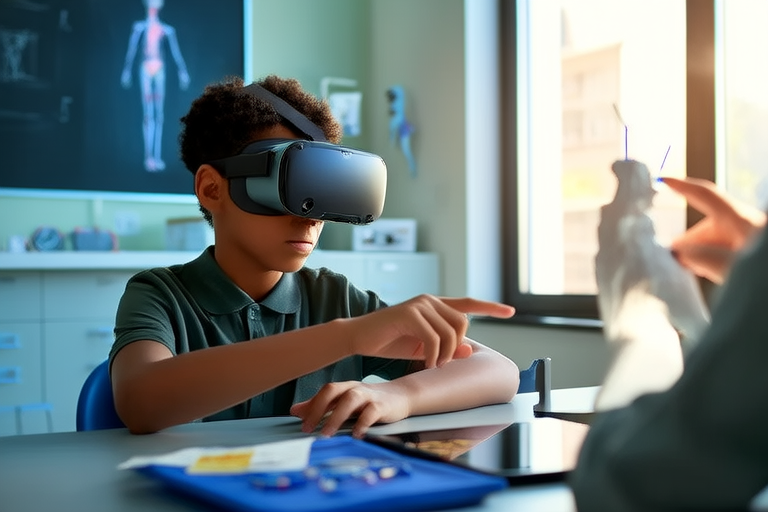Introduction
In recent years, technology has reshaped nearly every aspect of modern life, including education. Among the most promising advancements are Virtual Reality (VR) and Augmented Reality (AR), which have the potential to transform traditional learning environments into immersive, interactive spaces. These technologies enable students to transcend the limitations of textbooks and screens, offering hands-on experiences that foster deeper understanding and engagement. This article explores how VR and AR can revolutionize education by enhancing interactivity, accessibility, and experiential learning while addressing practical challenges and ethical considerations.
Understanding VR and AR
Virtual Reality (VR) immerses users in a completely simulated environment, often through the use of headsets or specialized equipment. By creating a sense of presence, VR allows learners to explore virtual worlds as if they were physically present. Augmented Reality (AR), on the other hand, overlays digital content onto the real world, blending physical and virtual elements. AR is typically accessed through smartphones, tablets, or AR glasses, making it more accessible for everyday use.
While VR provides an escape into fully constructed digital realms, AR enhances the real world with additional layers of information. Both technologies share a common goal: to create engaging, interactive experiences that go beyond what traditional media can offer.
Current Applications in Education
VR and AR are already being utilized in various educational settings, demonstrating their versatility and potential. For instance, VR is used in medical training to simulate surgeries, allowing students to practice complex procedures without risk to patients. Similarly, AR applications in science education enable students to visualize molecular structures or explore the anatomy of organisms in three dimensions.
In history and geography, VR transports students to ancient civilizations or distant countries, providing a first-person perspective on cultural landmarks and historical events. AR, meanwhile, enriches field trips by overlaying contextual information about artifacts or natural phenomena. These applications not only make learning more engaging but also cater to diverse learning styles, ensuring that every student can benefit from immersive experiences.
Benefits of Immersive Learning
The integration of VR and AR in education offers numerous advantages. One of the most significant benefits is enhanced engagement. Immersive technologies captivate students’ attention by transforming abstract concepts into tangible, interactive experiences. This heightened engagement often leads to improved retention and understanding of complex subjects.
Interactivity is another key advantage. Unlike passive methods of learning, such as reading or listening to lectures, VR and AR encourage active participation. Students can manipulate objects, conduct experiments, or navigate environments, fostering critical thinking and problem-solving skills. Furthermore, these technologies promote inclusivity by accommodating different learning preferences and abilities. For example, visually impaired students can benefit from haptic feedback in VR, while those with mobility challenges can explore inaccessible locations virtually.
Challenges and Limitations
Despite their potential, VR and AR face several challenges that hinder widespread adoption in education. Cost remains a significant barrier, as high-quality VR headsets and AR devices can be expensive. Schools with limited budgets may struggle to provide equitable access to these technologies, exacerbating existing disparities in educational resources.
Technical issues also pose obstacles. VR and AR systems require robust hardware and software infrastructure, which may not be available in all educational institutions. Additionally, prolonged use of VR can cause discomfort or motion sickness in some users, limiting its applicability for extended learning sessions.
Ethical considerations must also be addressed. The collection and use of personal data in VR and AR applications raise concerns about privacy and security. Moreover, over-reliance on immersive technologies could diminish opportunities for social interaction and collaboration, which are essential components of holistic education.
Future Possibilities
Looking ahead, the future of VR and AR in education is brimming with possibilities. Advances in technology are expected to reduce costs and improve accessibility, making these tools more widely available. Innovations such as standalone VR headsets and lightweight AR glasses could eliminate the need for bulky equipment, enabling seamless integration into classrooms.
Artificial intelligence (AI) combined with VR and AR could further personalize learning experiences. AI-driven algorithms could adapt content based on individual student performance, ensuring that each learner receives tailored support. Collaborative platforms may also emerge, allowing students from around the world to interact and solve problems together within shared virtual spaces.
As educators continue to explore creative ways to incorporate VR and AR, interdisciplinary approaches will likely become more prevalent. For example, combining VR with gamification techniques could make learning even more enjoyable and effective. The potential applications are virtually limitless, paving the way for a new era of experiential education.
Conclusion
Virtual Reality and Augmented Reality hold immense promise for revolutionizing education by creating immersive, interactive, and inclusive learning environments. While challenges such as cost, technical limitations, and ethical concerns persist, ongoing advancements suggest a bright future for these technologies. As schools and educators embrace VR and AR, they will unlock new opportunities for students to engage with knowledge in profound and meaningful ways. By looking beyond the screen, we can reimagine education as a dynamic, experiential journey that prepares learners for the complexities of the modern world.


